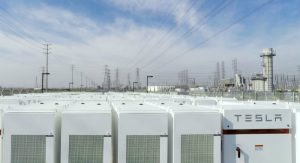
Only commissioned on December 1st, a Tesla megabattery (the Hornsdale facility) ‘stepped in’ to balance the grid – reacting in 70ms and beating by far the contracted 6 second response time from another power plant. Though ‘unexpected’, the value of battery support for electric grid operations has again demonstrated itself.
Last week the Loy Yang power station tripped without warning early in the morning. This produced an immediate loss to the grid of 560MW. In turn this produced a network frequency slump (it fell below 49.80Mhz). What happened next startled electricity industry professionals. The implications for grids in the future are only starting to seep in.
The failure
The Loy Yang A 3 power station is a brown coal power station located in Victoria, about 150 Kms east of Melbourne. It tripped without warning at 1.59AM.
Such events occur. But network frequency drops, beyond certain parameters, can damage equipment, especially customer equipment. To minimise any impact, electricity and/or network operators contract for emergency input to the network to restore the grid frequency.
In this case another coal powered generator – the Gladstone Power Station (some 2000Kms away in Queensland) possessed the contract to respond and deliver FCAS (Frequency Control and Ancillary Services). The contracted response time was a ‘normal’ six seconds.
The Tesla megabattery
On December 1st, 200 Kms north of Adelaide in South Australia, Tesla handed over the Hornsdale Power Reserve (HPR) megabattery. With a 100MW capacity it charges from power generated by the nearby Hornsdale windfarm run by Neoen.
This installation occurred as a result of Tesla CEO Elon Musk promising South Australia it could deliver a battery back systems inside 100 days from signing a contract (it beat this target easily). The justification for the HPR was ongoing electricity shortages, especially in summer. The megabattery was there to smooth out South Australia problems, but not ones 1000 Kms far to the east in Victoria.
What happened
Even before the Loy Yang A unit had ‘finished’ going offline, the HPR responded, injecting a little over 7MW into the network. This arrested the frequency slump, which had fallen below 49.80Hertz.
Initial data from the Australian Energy Market Operator or AEMO (and gathered above by Dylan McConnell from the Climate and Energy College) shows that the Tesla battery responded four seconds ahead of the contracted FCAS generator, the Gladstone power plant in Queensland.
Subsequent analysis showed that the megabattery responded in milliseconds, too fast for AEMO to measure. In milliseconds the HPR returned the frequency back to 50Mhz – and continued until the Gladstone feed took over as contracted. By this time the megabattery was down to less than 20% of its capacity.
What does this mean
While this was an elegant demonstration of the value of the Tesla installation, it was unexpected. There was no contract for it to support the failure caused in next door state Victoria. So why did it happen?
The simplest answer seems to be was that it could, and so it did. There may also be an undisclosed aspect to the HPR contract with the South Australian government, which may also contract for FCAS grid-relevant services.
The big takeaway, however, concerns energy in general and ‘clunky’ infrastructure (like electricity grids) in particular. Most assumed these to be antiques with modest susceptibility to improvement without massive investment.The Horndale megabattery, and Reactive Technologies’ GridMetrix, are examples which demonstrate that (relatively) inexpensive incremental steps are possible which can then make a big practical difference.

























